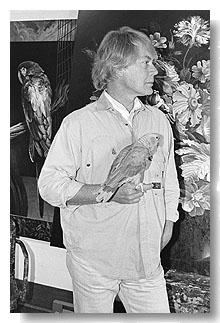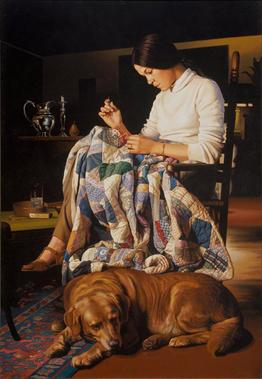Ian Hornak facts for kids
Quick facts for kids
Ian John Hornak
|
|
|---|---|

Hornak in his East Hampton, New York studio, 1997
|
|
| Born |
John Francis Hornak
January 9, 1944 Philadelphia, Pennsylvania, U.S.
|
| Died | December 9, 2002 (aged 58) |
| Education | University of Michigan–Dearborn (No degree) Wayne State University (BFA) |
| Occupation | Visual artist |
| Relatives | Julius Rosenthal Wolf (domestic partner)
Rosemary Hornak (sister) Eric Ian Spoutz (nephew) |
Ian Hornak (born January 9, 1944 – died December 9, 2002) was an American artist. He was a talented painter, draughtsman (someone who draws), and printmaker. Ian Hornak helped start the Hyperrealist and Photorealist art movements. He was known for being the first Photorealist to use a "multiple exposure" effect in his landscape paintings. He also expanded his paintings onto the frames, making the frame part of the art!
Contents
Early Life and Education
Ian Hornak was born on January 9, 1944, in Philadelphia, Pennsylvania. His parents, Frank and Rose, were immigrants from Slovakia. After he was born, his family moved to Brooklyn Heights, New York. His mom owned a candy shop there! Later, they moved to Mount Clemens, Michigan, where they bought a big farm.
Ian was a great student. He graduated from New Haven High School and was part of the National Honor Society. He went to the University of Michigan–Dearborn for a short time. Then, he transferred to Wayne State University in Detroit. There, he earned a Bachelor of Fine Arts degree in 1964. He also earned a Master of Fine Arts degree in 1966. From 1966 to 1968, he taught art classes at Henry Ford Community College and Wayne State University.
Art Career
While living in Detroit, Ian Hornak met Lowell Nesbitt. Nesbitt was a very successful artist in New York City. A Detroit art dealer named Gertrude Kasle introduced them.
In 1968, Hornak moved to New York City. He rented a studio from Nesbitt. They became good friends. Nesbitt introduced Hornak to many famous artists in the New York art scene. These artists included Willem de Kooning, Lee Krasner, Andy Warhol, and Alex Katz.
Nesbitt also introduced Hornak to his art dealer, Eleanor Ward. She showed Hornak's art in group exhibitions at her Stable Gallery. This was a very important gallery in New York City. However, Ward decided to close her gallery in 1970.
In 1970, Lee Krasner introduced Hornak to Jason McCoy. McCoy was the nephew of the famous artist Jackson Pollock. McCoy worked at the Tibor de Nagy Gallery. Because of Krasner's recommendation, the gallery signed Hornak. He had his first solo exhibition in New York City in 1971.
Hornak had many successful shows at Tibor de Nagy. His art sold out and received good reviews. But in 1976, he moved to the Fischbach Gallery. He stayed there until 1984.
In 1985, Jimmy Ernst suggested Hornak join the Armstrong Gallery. Jimmy Ernst was the son of artist Max Ernst. Hornak had one solo exhibition there.
In 1986, Hornak moved to the Katharina Rich Perlow Gallery. He had nine successful solo exhibitions there. He remained with this gallery until he passed away in 2002.
Ian Hornak's Artwork
When Ian Hornak was nine, his mother gave him oil paints. She also gave him a book of important Renaissance paintings. He was able to copy the works of artists like Michelangelo Buonarroti and Leonardo da Vinci. In 1976, Hornak said he learned his technique by copying art he liked. He especially loved Renaissance paintings because they were clear and well-organized.
During his college years, Hornak focused on painting realistic landscapes. These landscapes showed the countryside where he grew up. He also made many prints, mostly etchings. These prints were inspired by Renaissance and Baroque art.
In New York, Hornak was one of the first artists to create Photorealist artwork. Other Photorealist artists included Richard Estes and Chuck Close. This style of art was a reaction to the popular Pop Art movement at the time.


In 1970, Hornak showed his first landscape paintings from his "multiple exposure" series. He was the first Photorealist artist to use this idea in his paintings. This means he made his paintings look like photos taken with multiple exposures.
In 1985, Jimmy Ernst encouraged Hornak to try a new style. This led to a small series of paintings. These paintings showed landscapes that looked like they were from an apocalypse.
From 1986 until his death, Hornak painted botanical and still life artworks. These were inspired by Dutch and Flemish masters. During this time, he was known for being the first artist to extend his painting's imagery onto the frame itself. He said his flower paintings were less about just showing color and more about deeper meaning.
Hornak once said in an interview, "I have begun to stop resisting the constant urge to deny that beauty has a valid right to exist in contemporary art." He believed that beauty and spirituality were important in art.
Homes and Studios
Ian Hornak owned a home and a large studio in East Hampton (town), New York. He lived there from 1970 until he passed away in 2002. He also had a second studio in a penthouse in New York City's Upper East Side. This was near East 73rd Street and Park Avenue. Hornak spent winters in Sarasota, Florida, where he also owned a home and studio. He built this home to be close to his friend, Jimmy Ernst.
Artistic Influences
Hornak often said that artists from the Hudson River School greatly influenced him. These included Martin Johnson Heade and Frederic Edwin Church. He also admired the 19th-century German Romantic artist, Caspar David Friedrich.
Hornak explained his influences: "What I so like about Poussin and Cézanne is their sense of organization. I like the way in which they develop space and shape in architectural continuity - the rhythm across their paintings. When I paint a landscape, I get the greatest pleasure out of composing it. As I paint, I try to work out a visual sonata form or a fugue, with realistic images." He enjoyed creating a sense of order and rhythm in his art.
Personal Life
Ian Hornak had a younger sister, Rosemary Hornak, who was also an artist. She was the only person to inherit his estate. He also had a younger brother, Michael Hornak. His nephew, Eric Ian Spoutz, was named after him. Eric was an art dealer and managed Hornak's studio. Later, he became the executor of Hornak's estate.
Ian Hornak had a life partner from 1970 to 1976 named Julius Rosenthal Wolf. Wolf was a well-known American casting director and producer. He was also an art collector and art dealer. Wolf and Hornak lived in their homes in New York City and East Hampton, New York. After Wolf passed away in 1976, Frank Burton was Hornak's life partner until Burton's death in 1996.
Art Collection
Julius Rosenthal Wolf collected American Modernist and African American art. He learned a lot about these art styles when he worked at The Downtown Gallery. Later, Hornak introduced Wolf to the exciting contemporary art scene in New York City.
Together, Wolf and Hornak built a large art collection. When Wolf passed away in 1976, 95 artworks from their collection were given to Hood Museum of Art and the Hopkins Center for the Arts. These museums are at Dartmouth College, where Wolf went to school.
The collection included artworks by many famous artists. Some of these artists were David Burliuk, Arthur Dove, Marc Chagall, Roy Lichtenstein, and Robert Motherwell. The collection also had some of Ian Hornak's own paintings and drawings. One of these was a large portrait of Wolf, called "Jay Wolf." This collection is known as "The Jay Wolf Bequest of Contemporary Art." It was a very important gift to Dartmouth College in the 1970s.
Death and Legacy
Ian Hornak had an aortic aneurysm on November 17, 2002. This happened while he was painting in his studio in East Hampton (town), New York. He was taken to the Southampton Hospital for surgery. Sadly, he passed away on December 9, 2002, due to complications. He was 58 years old.
On January 21, 2011, Hornak was buried in the Forest Lawn Memorial Park, Glendale in Los Angeles County, California.
A special traveling art show called Transparent Barricades: Ian Hornak, A Retrospective began in 2011. It traveled to museums across the United States until 2016. In 2013, Hornak's art was also shown at the Board of Governors of the Federal Reserve System in Washington D.C. This exhibition was sponsored by the Ben Bernanke Administration.
Museum and Public Collections
Ian Hornak's personal papers and items became part of the Smithsonian Institution's Archives of American Art in 2007. His artwork is owned by many museums and public collections.
Some of these include:
- The Smithsonian Institution's National Museum of American Art
- The Smithsonian Institution's National Museum of American History
- The Library of Congress
- The Corcoran Gallery of Art
- The Detroit Institute of Arts
- The Board of Governors of the Federal Reserve System
- The Museum of Fine Arts, Boston
- The Hood Museum of Art at Dartmouth College
- The Detroit Historical Museum
- The Flint Institute of Arts
- The Forest Lawn Museum
- The Children's Hospital Boston (Harvard Medical School affiliate)
- The Long Island Museum of American Art, History, and Carriages
- The National Czech & Slovak Museum & Library
- The National Hellenic Museum
- The Jane Voorhees Zimmerli Art Museum at Rutgers University
- The Florida State Capital
- Wayne State University
In 2012, more of Hornak's papers and personal items were added to Dartmouth College's Rauner Special Collections Library.
Images for kids
-
Title: Hannah Tillich's Mirror: Rembrandt's Three Trees Transformed Into The Expulsion From Eden by Hornak, acrylic on canvas, 60 x 120 inches, 1978.
-
Marcia Sewing, Variation III by Hornak, acrylic on canvas, Museum of Fine Arts, Boston, 1978



